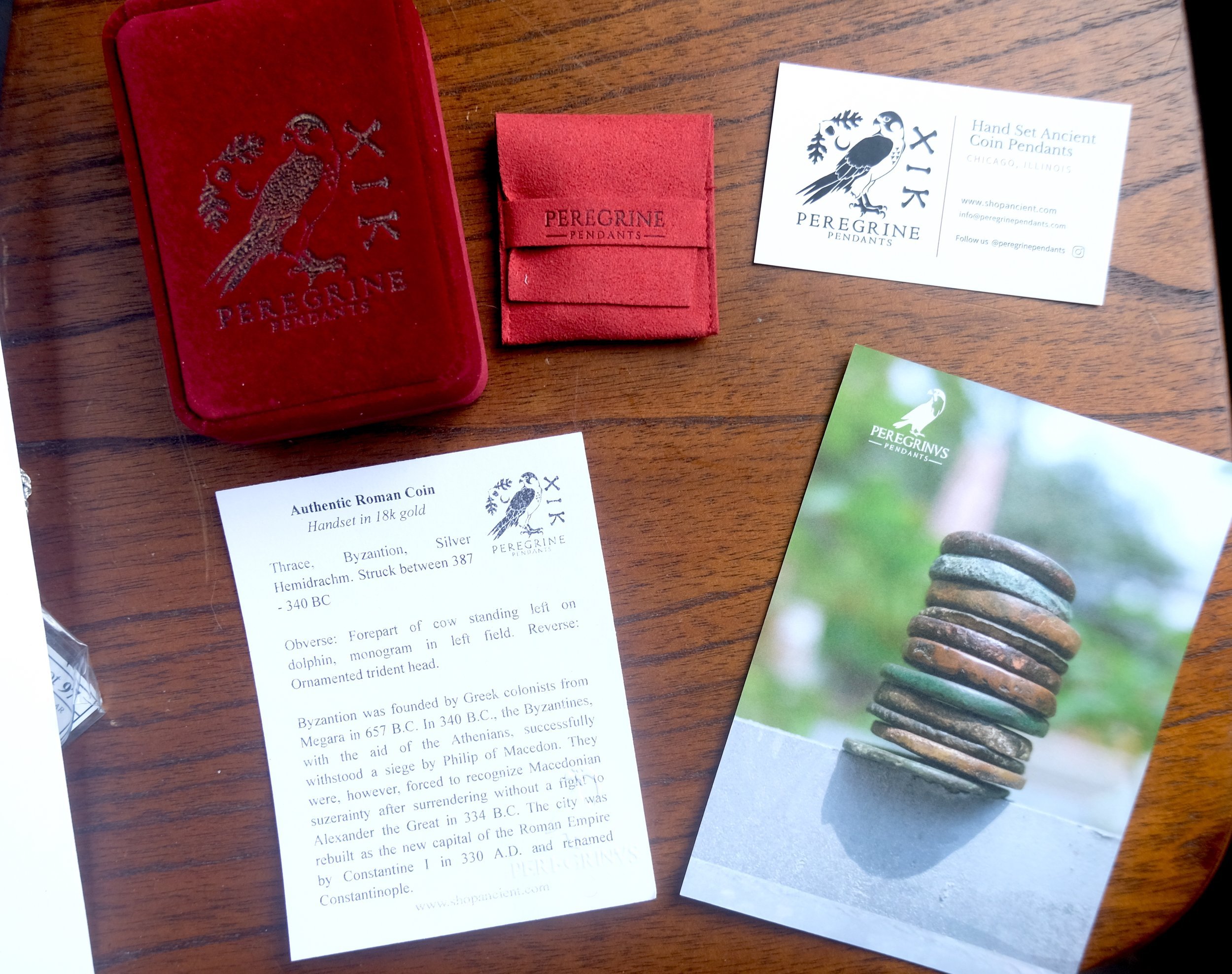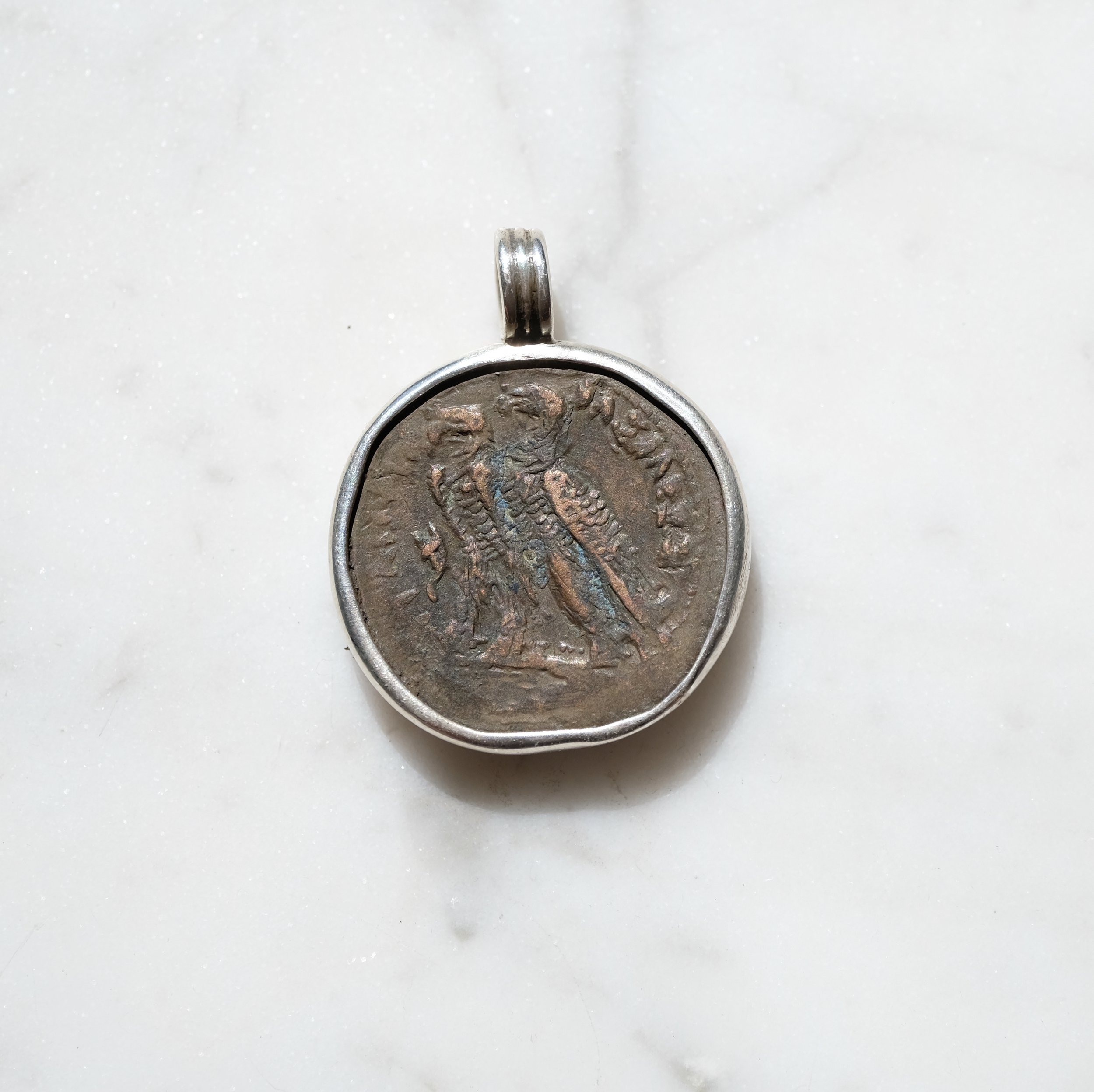 Image 1 of 4
Image 1 of 4

 Image 2 of 4
Image 2 of 4

 Image 3 of 4
Image 3 of 4

 Image 4 of 4
Image 4 of 4





Roma and Quadriga - Roman Republic 137 BC ancient Coin Pendant
Excellent ancient coin struck in 137 BC in Rome. Showing Roma and a quadriga (chariot with four horses).
To appreciate its size, the relief of the coin and the shape of the bail, see the picture showing the coin next to a US quarter. The coin was first set in a gold bezel, which was then hammered over the edge of both sides. This was then sanded and polished. This pendant is built to last.
Comes with certificate which guarantees authenticity and provides background information (listed below) on the acquired coin
-- Coin information:
Roman Republic, M. Baebius QF Tampilus - silver denarius
Obverse: Helmeted head of Roma left with ark of value before, TAMPIL behind.
Reverse: Apollo in quadriga right holding reins, arrow and branch, ROMA below, M BAEBI Q F in exergue.
Struck 137 BC
The denarius was the standard Roman silver coin from its introduction in the Second Punic War c. 211 BC to the reign of Gordian III (AD 238–244), when it was gradually replaced by the antoninianus. It continued to be minted in very small quantities, likely for ceremonial purposes, until and through the Tetrarchy (293–313). The word denarius is derived from the Latin dēnī "containing ten", as its value was originally of 10 assēs. The word for "money" descends from it in Italian (denaro), Slovene (denar), Portuguese (dinheiro), and Spanish (dinero). Its name also survives in the dinar currency.
www.shopancient.com
See all Peregrine Pendants jewelry: https://www.etsy.com/shop/PeregrineAncients
Follow on instagram @peregrinependants
****
.***
Why buy from Peregrine Pendants?
I specialize in setting ancient coins. As a collector, I create jewelry to share these amazing objects. Setting them, however, requires knowledge because of their irregular shapes. There are some quality competitors, but most sellers fall outside of that group. What’s even worse than a poorly set coin is one that is forced into pre-made bezels. These may be suitable for some modern, machine-made, coins, but they are not for hand-struck ancient coins. We offer a range of settings and of coin types. What setting works best depends on the coin’s characteristics and the customer’s preference. For thin coins, I prefer a prong setting, and for thicker ones, a bezel setting. I wrote a blog on settings on www.shopancient.com/blog/settings-for-coins for more information. Regarding pricing, many sellers take advantage of unaware buyers that think that something must be worth a lot since the coins are that old. In fact, many ancient coins can be bought for a modest price. It all depends on the coin and its quality. Certainly, if you are looking for an Athenian owl tetradrachm, you are going to have to spend quite a bit (www.shopancient.com/blog/athens-owl-coin) When I am done setting, I research the competition before I price any pendant. Through this process, I think I offer my items at unbeatable prices. Feel free to message me if you think you found a better deal elsewhere (for the same coin type, in a similar condition, and set in the same way).
Import fees, duties, customs fees etc. charged by the buyer's country will be the sole responsibility of the buyer. It is impossible for me to know what these fees are so please direct your questions on these matters to your country's customs department. I cannot refund postage on orders that are returned because of customs issues, including refusal to pay customs on the part of the buyer.
Excellent ancient coin struck in 137 BC in Rome. Showing Roma and a quadriga (chariot with four horses).
To appreciate its size, the relief of the coin and the shape of the bail, see the picture showing the coin next to a US quarter. The coin was first set in a gold bezel, which was then hammered over the edge of both sides. This was then sanded and polished. This pendant is built to last.
Comes with certificate which guarantees authenticity and provides background information (listed below) on the acquired coin
-- Coin information:
Roman Republic, M. Baebius QF Tampilus - silver denarius
Obverse: Helmeted head of Roma left with ark of value before, TAMPIL behind.
Reverse: Apollo in quadriga right holding reins, arrow and branch, ROMA below, M BAEBI Q F in exergue.
Struck 137 BC
The denarius was the standard Roman silver coin from its introduction in the Second Punic War c. 211 BC to the reign of Gordian III (AD 238–244), when it was gradually replaced by the antoninianus. It continued to be minted in very small quantities, likely for ceremonial purposes, until and through the Tetrarchy (293–313). The word denarius is derived from the Latin dēnī "containing ten", as its value was originally of 10 assēs. The word for "money" descends from it in Italian (denaro), Slovene (denar), Portuguese (dinheiro), and Spanish (dinero). Its name also survives in the dinar currency.
www.shopancient.com
See all Peregrine Pendants jewelry: https://www.etsy.com/shop/PeregrineAncients
Follow on instagram @peregrinependants
****
.***
Why buy from Peregrine Pendants?
I specialize in setting ancient coins. As a collector, I create jewelry to share these amazing objects. Setting them, however, requires knowledge because of their irregular shapes. There are some quality competitors, but most sellers fall outside of that group. What’s even worse than a poorly set coin is one that is forced into pre-made bezels. These may be suitable for some modern, machine-made, coins, but they are not for hand-struck ancient coins. We offer a range of settings and of coin types. What setting works best depends on the coin’s characteristics and the customer’s preference. For thin coins, I prefer a prong setting, and for thicker ones, a bezel setting. I wrote a blog on settings on www.shopancient.com/blog/settings-for-coins for more information. Regarding pricing, many sellers take advantage of unaware buyers that think that something must be worth a lot since the coins are that old. In fact, many ancient coins can be bought for a modest price. It all depends on the coin and its quality. Certainly, if you are looking for an Athenian owl tetradrachm, you are going to have to spend quite a bit (www.shopancient.com/blog/athens-owl-coin) When I am done setting, I research the competition before I price any pendant. Through this process, I think I offer my items at unbeatable prices. Feel free to message me if you think you found a better deal elsewhere (for the same coin type, in a similar condition, and set in the same way).
Import fees, duties, customs fees etc. charged by the buyer's country will be the sole responsibility of the buyer. It is impossible for me to know what these fees are so please direct your questions on these matters to your country's customs department. I cannot refund postage on orders that are returned because of customs issues, including refusal to pay customs on the part of the buyer.
Excellent ancient coin struck in 137 BC in Rome. Showing Roma and a quadriga (chariot with four horses).
To appreciate its size, the relief of the coin and the shape of the bail, see the picture showing the coin next to a US quarter. The coin was first set in a gold bezel, which was then hammered over the edge of both sides. This was then sanded and polished. This pendant is built to last.
Comes with certificate which guarantees authenticity and provides background information (listed below) on the acquired coin
-- Coin information:
Roman Republic, M. Baebius QF Tampilus - silver denarius
Obverse: Helmeted head of Roma left with ark of value before, TAMPIL behind.
Reverse: Apollo in quadriga right holding reins, arrow and branch, ROMA below, M BAEBI Q F in exergue.
Struck 137 BC
The denarius was the standard Roman silver coin from its introduction in the Second Punic War c. 211 BC to the reign of Gordian III (AD 238–244), when it was gradually replaced by the antoninianus. It continued to be minted in very small quantities, likely for ceremonial purposes, until and through the Tetrarchy (293–313). The word denarius is derived from the Latin dēnī "containing ten", as its value was originally of 10 assēs. The word for "money" descends from it in Italian (denaro), Slovene (denar), Portuguese (dinheiro), and Spanish (dinero). Its name also survives in the dinar currency.
www.shopancient.com
See all Peregrine Pendants jewelry: https://www.etsy.com/shop/PeregrineAncients
Follow on instagram @peregrinependants
****
.***
Why buy from Peregrine Pendants?
I specialize in setting ancient coins. As a collector, I create jewelry to share these amazing objects. Setting them, however, requires knowledge because of their irregular shapes. There are some quality competitors, but most sellers fall outside of that group. What’s even worse than a poorly set coin is one that is forced into pre-made bezels. These may be suitable for some modern, machine-made, coins, but they are not for hand-struck ancient coins. We offer a range of settings and of coin types. What setting works best depends on the coin’s characteristics and the customer’s preference. For thin coins, I prefer a prong setting, and for thicker ones, a bezel setting. I wrote a blog on settings on www.shopancient.com/blog/settings-for-coins for more information. Regarding pricing, many sellers take advantage of unaware buyers that think that something must be worth a lot since the coins are that old. In fact, many ancient coins can be bought for a modest price. It all depends on the coin and its quality. Certainly, if you are looking for an Athenian owl tetradrachm, you are going to have to spend quite a bit (www.shopancient.com/blog/athens-owl-coin) When I am done setting, I research the competition before I price any pendant. Through this process, I think I offer my items at unbeatable prices. Feel free to message me if you think you found a better deal elsewhere (for the same coin type, in a similar condition, and set in the same way).
Import fees, duties, customs fees etc. charged by the buyer's country will be the sole responsibility of the buyer. It is impossible for me to know what these fees are so please direct your questions on these matters to your country's customs department. I cannot refund postage on orders that are returned because of customs issues, including refusal to pay customs on the part of the buyer.
You Might Also Like



















